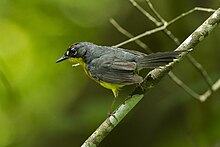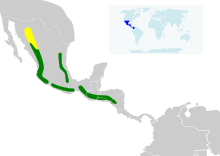38:
82:
203:
57:
277:. Vagrant records exist for Arizona, New Mexico and Texas. It is yellow on its throat and underparts with a tawny wash on its chest. The head is gray with a black-framed yellow crown and white around the eyes. The undertail coverlets are white. They are 5.8-6.3 in (14.5–16 cm) long and have pleasant, upslurred song. Fan-tailed warblers live in and at the edge of
304:, wherein prey that has been roused or disturbed by the foraging or hunting of another animal is opportunistically captured. They have been observed following and foraging for prey near
775:
665:
745:
603:
639:
398:"Commensal foraging by a fan-tailed warbler (Euthlypis lachrymosa) with a nine-banded armadillo (Dasypus nocemcinctus) in southwestern Mexico"
37:
755:
459:
445:
780:
644:
770:
517:
508:
81:
765:
554:
670:
760:
678:
192:
416:
683:
541:
470:
559:
750:
313:
176:
429:
374:
533:
46:
329:
due to its unique morphology, but its nest, eggs, voice, and juvenile plumage are consistent with
229:
76:
704:
657:
618:
577:
455:
441:
257:
143:
20:
709:
412:
369:
278:
546:
722:
691:
320:
202:
397:
351:
428:
BirdLife
International (2007) Species factsheet: Euthlypis lachrymosa. Downloaded from
739:
652:
360:
66:
61:
582:
301:
294:
265:
153:
569:
493:
626:
502:
717:
309:
290:
274:
133:
93:
19:
This article is about the New World warbler. For the Old World warbler, see
696:
487:
305:
113:
608:
528:
631:
282:
270:
103:
464:
430:
https://web.archive.org/web/20210828092113/https://www.birdlife.org/
595:
590:
261:
123:
468:
286:
437:
A Guide to the Birds of Mexico and
Northern Central America
417:
10.1894/0038-4909(2006)51[560:cfbafw]2.0.co;2
396:
Schaefer, Richard R.; Jesse F. Fagan (December 2006).
477:
439:. Oxford University Press, Oxford & New York.
375:10.2305/IUCN.UK.2020-3.RLTS.T22721955A137221917.en
319:The fan-tailed warbler is sometimes placed in the
297:or close to it. They are found alone or in pairs.
269:that lives along the Pacific slope from northern
435:Howell, Steven N. G. & Webb, Sophie (1995):
452:A Guide to the Birds of Panama Second Edition
8:
293:, and are seen hopping around on either the
300:Fan-tailed warblers are known to engage in
465:
281:and semideciduous forest, especially near
201:
55:
36:
27:
373:
342:
776:Taxa named by Charles Lucien Bonaparte
7:
746:IUCN Red List least concern species
361:IUCN Red List of Threatened Species
222: Breeding and wintering range
14:
80:
350:BirdLife International (2020).
1:
405:The Southwestern Naturalist
797:
18:
368:: e.T22721955A137221917.
235:
228:
209:
200:
182:
175:
77:Scientific classification
75:
53:
44:
35:
30:
756:Birds of Central America
723:Basileuterus-lachrymosus
509:Basileuterus lachrymosus
479:Basileuterus lachrymosus
354:Basileuterus lachrymosus
253:Basileuterus lachrymosus
186:Basileuterus lachrymosus
781:Birds described in 1850
454:by Ridgely and Gwynne
314:nine-banded armadillos
771:Birds of El Salvador
238:Euthlypis lachrymosa
215: Breeding range
168:B. lachrymosus
47:Conservation status
31:Fan-tailed warbler
766:Birds of Guatemala
619:fan-tailed-warbler
248:fan-tailed warbler
733:
732:
705:Open Tree of Life
471:Taxon identifiers
448:
302:commensal feeding
258:New World warbler
244:
243:
70:
21:zitting cisticola
788:
726:
725:
713:
712:
700:
699:
687:
686:
674:
673:
661:
660:
648:
647:
635:
634:
622:
621:
612:
611:
599:
598:
586:
585:
573:
572:
563:
562:
550:
549:
537:
536:
534:C35381D053F6E00D
524:
523:
513:
512:
511:
498:
497:
496:
466:
440:
421:
420:
402:
393:
387:
386:
384:
382:
377:
347:
221:
214:
205:
188:
85:
84:
64:
59:
58:
40:
28:
796:
795:
791:
790:
789:
787:
786:
785:
761:Birds of Mexico
736:
735:
734:
729:
721:
716:
708:
703:
695:
692:Observation.org
690:
682:
677:
669:
664:
656:
651:
643:
638:
630:
625:
617:
615:
607:
602:
594:
589:
581:
576:
568:
566:
558:
553:
545:
540:
532:
527:
521:
516:
507:
506:
501:
492:
491:
486:
473:
425:
424:
400:
395:
394:
390:
380:
378:
349:
348:
344:
339:
224:
223:
219:
217:
216:
212:
196:
190:
184:
171:
79:
71:
60:
56:
49:
24:
17:
16:Species of bird
12:
11:
5:
794:
792:
784:
783:
778:
773:
768:
763:
758:
753:
748:
738:
737:
731:
730:
728:
727:
714:
701:
688:
675:
662:
649:
636:
623:
613:
600:
587:
574:
564:
551:
538:
525:
514:
499:
483:
481:
475:
474:
469:
463:
462:
449:
433:
423:
422:
388:
341:
340:
338:
335:
242:
241:
233:
232:
226:
225:
218:
211:
210:
207:
206:
198:
197:
191:
180:
179:
173:
172:
165:
163:
159:
158:
151:
147:
146:
141:
137:
136:
131:
127:
126:
121:
117:
116:
111:
107:
106:
101:
97:
96:
91:
87:
86:
73:
72:
54:
51:
50:
45:
42:
41:
33:
32:
15:
13:
10:
9:
6:
4:
3:
2:
793:
782:
779:
777:
774:
772:
769:
767:
764:
762:
759:
757:
754:
752:
749:
747:
744:
743:
741:
724:
719:
715:
711:
706:
702:
698:
693:
689:
685:
680:
676:
672:
667:
663:
659:
654:
650:
646:
641:
637:
633:
628:
624:
620:
614:
610:
605:
601:
597:
592:
588:
584:
579:
575:
571:
565:
561:
556:
552:
548:
543:
539:
535:
530:
526:
519:
515:
510:
504:
500:
495:
489:
485:
484:
482:
480:
476:
472:
467:
461:
460:0-691-02512-6
457:
453:
450:
447:
446:0-19-854012-4
443:
438:
434:
431:
427:
426:
418:
414:
411:(4): 560–61.
410:
406:
399:
392:
389:
376:
371:
367:
363:
362:
357:
355:
346:
343:
336:
334:
332:
328:
327:
322:
317:
315:
311:
307:
303:
298:
296:
292:
289:, especially
288:
284:
280:
276:
272:
268:
267:
263:
259:
255:
254:
249:
240:
239:
234:
231:
227:
208:
204:
199:
194:
189:
187:
181:
178:
177:Binomial name
174:
170:
169:
164:
161:
160:
157:
156:
152:
149:
148:
145:
142:
139:
138:
135:
134:Passeriformes
132:
129:
128:
125:
122:
119:
118:
115:
112:
109:
108:
105:
102:
99:
98:
95:
92:
89:
88:
83:
78:
74:
68:
63:
62:Least Concern
52:
48:
43:
39:
34:
29:
26:
22:
751:Basileuterus
478:
451:
436:
408:
404:
391:
379:. Retrieved
365:
359:
353:
345:
331:Basileuterus
330:
325:
324:
318:
299:
295:forest floor
266:Basileuterus
264:
252:
251:
247:
245:
237:
236:
185:
183:
167:
166:
155:Basileuterus
154:
25:
679:Neotropical
627:iNaturalist
503:Wikispecies
432:on 8/8/2007
381:11 November
285:. They eat
740:Categories
718:Xeno-canto
337:References
310:passerines
494:Q27075999
326:Euthlypis
321:monotypic
306:army ants
291:army ants
279:evergreen
275:Nicaragua
193:Bonaparte
162:Species:
144:Parulidae
100:Kingdom:
94:Eukaryota
658:22721955
547:22721955
542:BirdLife
488:Wikidata
308:, other
230:Synonyms
140:Family:
114:Chordata
110:Phylum:
104:Animalia
90:Domain:
67:IUCN 3.1
609:6092627
529:Avibase
283:ravines
260:in the
256:) is a
150:Genus:
130:Order:
120:Class:
65: (
710:335230
697:262271
684:fatwar
671:182927
645:950078
632:145259
616:GNAB:
596:fatwar
570:fatwar
560:670001
522:fatawa
458:
444:
323:genus
312:, and
271:Mexico
220:
213:
195:, 1850
591:eBird
583:5WD94
567:BOW:
401:(PDF)
262:genus
666:NCBI
653:IUCN
640:ITIS
604:GBIF
555:BOLD
456:ISBN
442:ISBN
383:2021
366:2020
287:ants
246:The
124:Aves
578:CoL
518:ABA
413:doi
370:doi
273:to
742::
720::
707::
694::
681::
668::
655::
642::
629::
606::
593::
580::
557::
544::
531::
520::
505::
490::
409:51
407:.
403:.
364:.
358:.
333:.
316:.
419:.
415::
385:.
372::
356:"
352:"
250:(
69:)
23:.
Text is available under the Creative Commons Attribution-ShareAlike License. Additional terms may apply.

